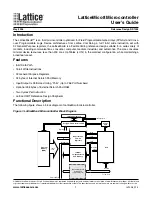
60
CY8C28xxx PSoC Programmable System-on-Chip TRM, Document No. 001-52594 Rev. *G
RAM Paging
4.2
Register Definitions
The following registers are associated with RAM Paging and are listed in address order. The register descriptions have an
associated register table showing the bit structure for that register. The bits in the tables that are grayed out are reserved bits
and are not detailed in the register descriptions that follow. Reserved bits should always be written with a value of ‘0’. For a
complete table of RAM Paging registers, refer to the
“Summary Table of the Core Registers” on page 36
.
4.2.1
TMP_DRx Registers
The Temporary Data Registers (TMP_DR0, TMP_DR1,
TMP_DR2, and TMP_DR3) are used to enhance the perfor-
mance in multiple SRAM page PSoC devices.
These registers have no pre-defined function (for example,
the compiler and hardware do not use these registers) and
exist for the user to use as desired.
Bits 7 to 0: Data[7:0].
Due to the paged SRAM architec-
ture of PSoC devices with more than 256 bytes of SRAM, a
value in SRAM may not always be accessible without first
changing the current page. The TMP_DRx registers are
readable and writeable registers that are provided to
improve the performance of multiple SRAM page PSoC
devices, by supplying some register space for data that is
always accessible.
For an expanded listing of the TMP_DRx registers, refer to
the
“Summary Table of the Core Registers” on page 36
. For
additional information, refer to the
.
4.2.2
CUR_PP Register
The Current Page Pointer Register (CUR_PP) is used to set
the effective SRAM page for normal memory accesses in a
multi-SRAM page PSoC device.
Bits 2 to 0: Page Bits[2:0].
These bits affect the SRAM
page that is accessed by an instruction when the
CPU_F[7:0] bits have a value of either 10b or 11b. Source
indexed and destination indexed addressing modes, as well
as stack instructions, are never affected by the value of the
CUR_PP register. (See the STK_PP and IDX_PP registers
for more information.)
The source indirect post increment and destination indirect
post increment addressing modes, better know as MVI, are
only partially affected by the value of the CUR_PP register.
For MVI instructions, the pointer address is in the SRAM
page indicated by CUR_PP, but the address pointed to may
be in another SRAM page. See the MVR_PP and MVW_PP
register descriptions for more information.
For additional information, refer to the
Address
Name
Bit 7
Bit 6
Bit 5
Bit 4
Bit 3
Bit 2
Bit 1
Bit 0
Access
x,6xh
Data[7:0]
RW : 00
LEGEND
x
An ‘x’ before the comma in the address field indicates that this register can be read or written to no matter what bank is used. An “x” after the comma in the
address field indicates that there are multiple instances of the register.
Address
Name
Bit 7
Bit 6
Bit 5
Bit 4
Bit 3
Bit 2
Bit 1
Bit 0
Access
0,D0h
Page Bits[2:0]
RW : 00
Summary of Contents for CY8C28 series
Page 65: ...64 CY8C28xxx PSoC Programmable System on Chip TRM Document No 001 52594 Rev G RAM Paging ...
Page 125: ...124 CY8C28xxx PSoC Programmable System on Chip TRM Document No 001 52594 Rev G ...
Page 311: ...310 CY8C28xxx PSoC Programmable System on Chip TRM Document No 001 52594 Rev G IDAC_CR0 1 FDh ...
Page 317: ...316 CY8C28xxx PSoC Programmable System on Chip TRM Document No 001 52594 Rev G ...
Page 393: ...392 CY8C28xxx PSoC Programmable System on Chip TRM Document No 001 52594 Rev G ...
Page 477: ...476 CY8C28xxx PSoC Programmable System on Chip TRM Document No 001 52594 Rev G Digital Clocks ...
Page 561: ...560 CY8C28xxx PSoC Programmable System on Chip TRM Document No 001 52594 Rev G ...
















































